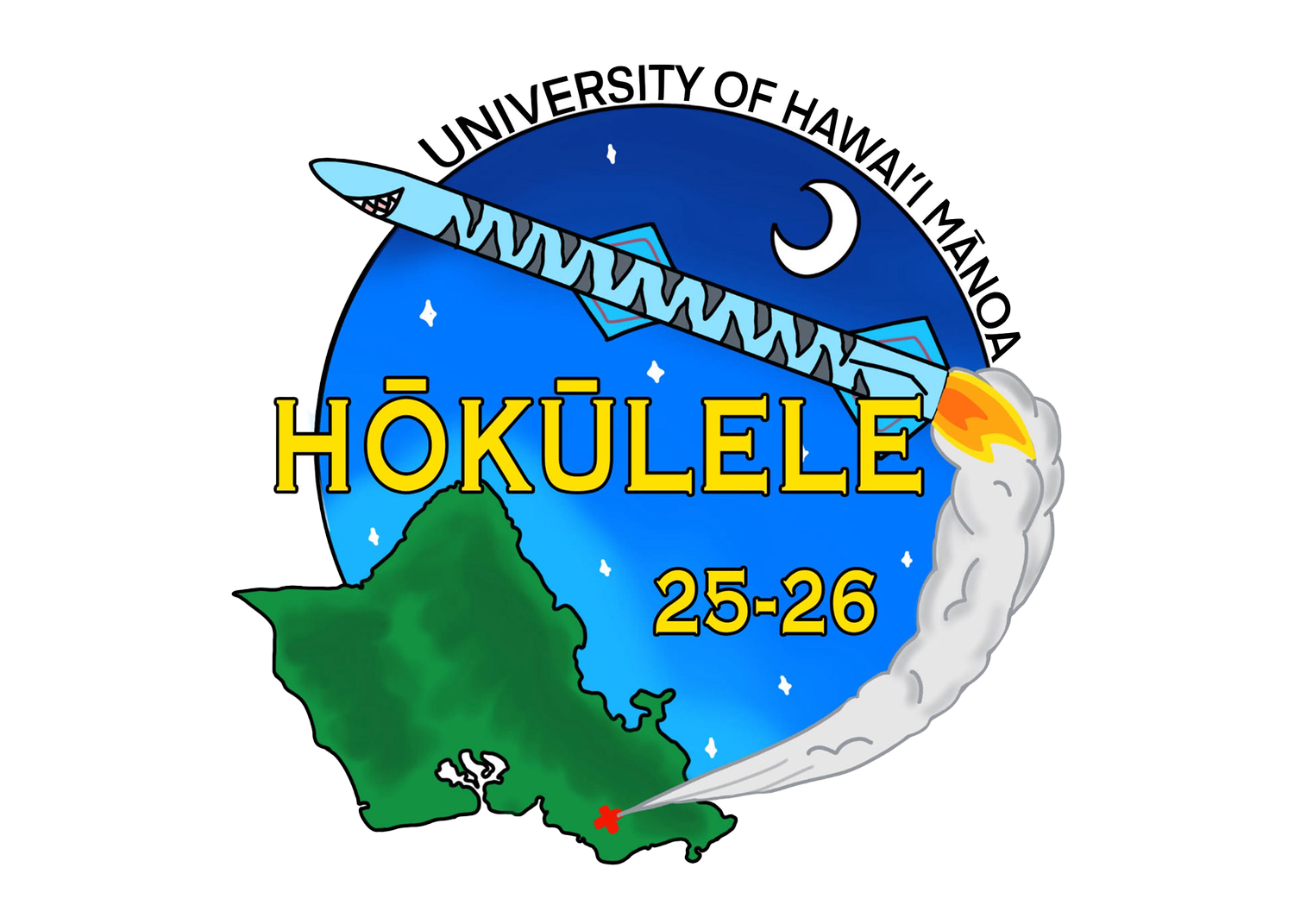2025-2026 Team Hokulele project
2025-2026 Team Hokulele project
Technical Overview
This is the rocket design that the team has created. It has four sections: Nose Cone, Forward, Sustainer, and Booster. In addition to a competition-required water-ballast, the payload will feature a water resupply mission and a multi-camera payload. Avionics will be located in three parts of the rocket, the Nose Cone, Forward and the Booster section; the avionics will be in charge of making sure the recovery components deploy at the correct times. Lastly the rocket will feature two motors, the N3300R and the M1939W both from Aerotech.
FAR-Unlimited Competition
The FAR-Unlimited, is a rocket launch contest held by the Friends of Amateur Rocketry whose goal is to educate the public about STEM using amateur rocketry. The competition is held at the FAR launch facility located between the Rand and El Paso mountains in California and is open to college, university, and amateur rocket teams. Teams will launch solid, liquid, and hybrid motor rockets containing various payloads with target altitudes of 5,000, 10,000, and 25,000 feet.
2025-2026 Goals
Design and build a rocket that reaches an altitude of 25,000 ft.
Design and build a multi-function payload
Live stream live video footage from the rocket to the ground station
Achieve 1,000 points for two-stage rocket in the FAR-Unlimited competition
Design and implement a safe and successful recovery system
Design a ground station which receives live data from the rocket
Graduate from the University of Hawaii at Mānoa in Spring 2026
Win the 2026 FAR-Unlimited Competition
System Architecture
Team Hōkūlele’s subsystems will coordinate in both the design and fabrication of the rocket to achieve success within the project. The team will also have external relationships outside the team which will complement the team in project completion. Dr. Trevor Sorensen will oversee the project, acting as both a guide and a customer for the project. He will define essential requirements and constraints for the team that will be addressed throughout the project duration, as well as overview reports and deliverables that mark project milestones. In addition, both Dr. Trevor Sorensen and Dr. Jacob Hudson will provide guidance throughout the project to ensure requirements are met and verified. This includes assistance in the defining of the rocket at a system level and its subsystems, alongside the design and fabrication of the components of the rocket. For funding, Team Hōkūlele will be in contact with multiple external organizations. This includes the University of Hawaii’s College of Engineering (COE) department, which will provide initial funding alongside lab equipment and machine access to complement the fabrication of rocket parts, as well as request for grants and sponsorships from other external organizations. Given proper fulfillment of requirements, the rocket itself will be delivered to FAR, which will be used in the 2025 FAR-Unlimited competition.
Overall Work Breakdown Structure
This the overall work breakdown structure for the team. It features each subsystem along with all their responsibilities. Administration is focused around budget, scheduling, and communication between the subsystems. Structure is focused on the structure of the rocket as well as the fins and making sure it is structurally strong enough to survive the conditions of the flight. The propulsions subsystem is in charge of the motors and everything related to the motors, being the estimated reach, testing, assembly, and its integration into the rocket body. The recovery subsystem is in charge of the recovery components. The payload subsystem is tasked with designing a payload with multiple cameras and a water resupply mission in order to earn the greatest amount of points possible. The avionics and ground station subsystem is in charge of all signal propagation to and from the rocket as well as the avionics components inside the rocket. Ground station will then present live video feed, telemetry data, and live flight profile in an easy to understand, user-friendly user interface.
Structure
Design and fabricate a rocket frame that provides overall mechanical integrity to the system
The structure should be able to withstand forces experienced during the entire flight sequence and support all interior components of the rocket
Update previous year’s body tube and fin design in a way that improves the rocket's stability and targets an apogee of 25,000 feet
Propulsion
Determine the motors needed to propel the rocket to a target altitude of 25,000 feet
Integrate sustainer and booster into the rocket structure to ensure successful ignition and separation
Record motor performance data through static motor testing at Windward Community College
CAD Design of M1939W Sustainer
Recovery
Ensure the onboard avionics deploy parachutes at the optimum time that the rocket reaches its maximum apogee to recover the rocket safely
Integrate an improved recovery system utilizing a combination of methods that will reduce the shock experienced by the rocket when the parachute opens and prevent damage to the rocket’s internal components
Sustainer, Booster and Nose cone AV bays
Stage 1 Deployment System
Payload
Fabricate and assemble a payload system
Ensure the payload system is durable enough to withstand the forces felt throughout the flight
Transmit live video feed to the ground station, capturing the entire flight
Record video onboard using a secondary camera
Carry and deploy a 0.53 gal (2L) water resupply container
Implement a 0.13 gal (500 mL) water ballast
Conceptual SolidWorks Design of Water Ballast
Conceptual Onshape Design of Nadir View
Conceptual Onshape Design of Payload Housing
Avionics and Ground Station
Responsible for all avionics components and signal propagation to and from the rocket
Receives real-time telemetry from rocket flight computers
Receives live video feed
Finance
Ensure that the project is funded
Ensure that the team is able to secure necessary resources within a timely manner and cost
Current Funds Raised: $6,729.02
Projected Expenses: $20,944.59





















